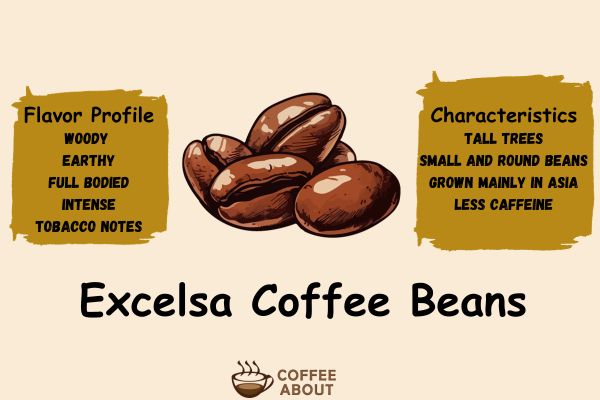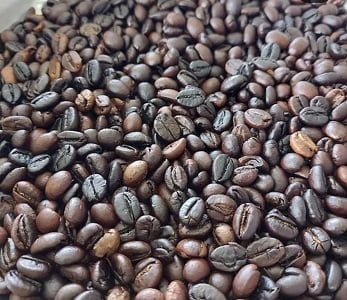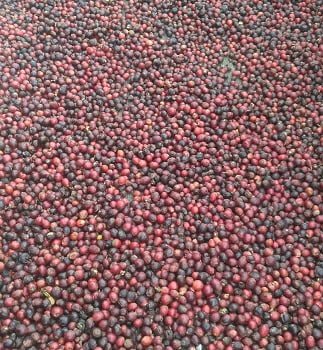Excelsa coffee used to be one of the four main coffee varieties – Arabica, Robusta, Liberica, and Excelsa. But in 2006, it got put into the Liberica category.
It only makes up 2% of the world’s coffee output, but it’s definitely worth giving it a shot!
Key Takeaways
- Excelsa tree has a tall, vertical structure reaching up to 50 ft.
- Excelsa thrives best at 1,000-1,300 ft elevations with ample rainfall.
- Excelsa has a complex, woody flavor profile with tobacco-like notes.
- It requires dark roasting to fully develop its dense, low-soluble bean structure.
- Excelsa is more resilient than Arabica and Robusta, so may be key for climate change.

In this article, I’ll walk you through Excelsa’s origins, optimal growing conditions, production challenges, and of course – tasting notes!
As an Amazon Associate, I earn commission from qualifying purchases.
What is Excelsa coffee?
Excelsa coffee is a unique coffee variety known for its distinct and sharp flavor profile. This variety was discovered in the 20th century in Central Africa and classified as dewevrei (a sub-variety of Liberica Coffee) in 2005.

The size of Excelsa Coffee beans are much smaller and rounder and have a deeply grooved seam right down the middle.
Excelsa stands out among other coffee types due to its unconventional flavor, which includes a notable sharpness, woody and earthy notes.
The caffeine content in Excelsa Coffee is around 0.94% on a dry matter basis which is lower compared to both Arabica (1.2%) and Robusta (2.6%).
Excelsa beans are typically used in Arabica Blends, adding a distinctive and exotic quality to the flavor profile.
The regions and cultivation of Excelsa coffee
Excelsa coffee is mostly cultivated in Southeast Asia these days, with the major producers being Indonesia, Malaysia, and the Philippines.
The trees thrive best at altitudes ranging from around 1,000 to 1,300 feet where there is lots of rainfall.
Unlike typical coffee shrubs, Excelsa grows more like an actual tree, with a single main trunk that can reach up to 50 feet tall!
This arboreal structure means Excelsa needs plenty of vertical space to stretch its branches and grow properly. The trees produce huge leathery leaves to soak up the tropical environs.
Cultivating Excelsa takes extensive care compared to other coffee varieties. While the trees are quite resilient and productive when conditions are right, they can be difficult to manage.

The challenges in growing Excelsa
Excelsa Coffee is not very popular as it presents several challenges. For one, the tall tree-like structure of Excelsa plants makes them difficult to manage, especially when grown on steep slopes.
The vertical height requires pruning multiple times per year to stimulate ideal fruiting plus harvesting cherries from taller trees is also very labor extensive. This additional labor means very high production costs.
Additionally, there simply isn’t much modern research available on this rare species compared to the wealth of data on growing Arabica and Robusta coffee. So farmers have limited scientific guidance when caring for these uncommon trees.
And since Excelsa is far less common globally, there is no established commodity market or standardized pricing for these beans. So farmers don’t have the buying security and more mainstream coffee offers.
Given the extra work coupled with unreliable buyers, many growers opt for easier-to-manage coffee crops instead.

What does Excelsa coffee taste like?
Excelsa coffee delivers a truly complex taste and unique flavor profile. The beans are typically processed using a natural method, allowing the coffee cherry to ferment for a few days, bringing out berry-like flavors.
Excelsa has far fewer soluble solids than Arabica and Robusta, so the beans require a darker roast at higher temperatures to fully develop. Light roasts just can’t pull enough flavor from the dense seeds.
When roasted deep, Excelsa shines with a rum-like, full body and creamy mouthfeel along with woody and even popcorn-y flavors.
There are often rich mocha, chocolate, and nutty impressions as well when the beans are taken to an extra dark roast.
The intense taste profile and heavy full-bodied finish make Excelsa a favorite for blending with milder Arabicas. On its own, Excelsa brews a bold, smoky cup with a rustic personality.
I’ve tried Excelsa beans and I am not a huge fan. The dark roast made it too smoky and masked the fruitiness I prefer. And the lack of sweetness didn’t appeal to my palate. The drink has a strong tobacco and earthy aroma but lacks the inviting notes I usually enjoy.
How’s Excelsa coffee different from Liberica
Excelsa and Liberica, both towering coffee trees, had their separate identities until 2006 when Excelsa became a subspecies of Liberica.
For starters, the trees do look similar – both Liberica and Excelsa grow much taller and with elongated branches compared to Arabica and Robusta’s shrub-like structures.
However, there are some differences between the two varieties:
- Excelsa beans themselves are noticeably smaller and rounder whereas Liberica beans are large and almond-shaped.
- The other major difference is inside the beans. Excelsa beans have a very dense structure and low percentage of dissolved solids and Liberica beans are more porous and contain more sweetness.
- When brewed, Liberica yields a fruitier, mellower cup while Excela prepares a bolder, woodier profile.
While related botanically, the bean structure and resulting flavor of these two tall tree coffees definitely stand apart.
The Future Potential of Excelsa Coffee
As weather patterns shift with climate change, researchers suggest shifting focus to sturdier coffee varieties beyond traditional Arabica and Robusta plants.
This is where hardy, productive Liberica and Excelsa coffee varieties come in. The tall Excelsa tree is far more resilient to rising temperatures and extreme weather swings.
Its strong roots can better withstand flooding compared to vulnerable Arabica crops.
Some farms are even using Excelsa stalks as grafting rootstock onto which Arabica and Robusta branches can be fused. The vigorous Excelsa base lends strength while the grafted branches yield more popular beans.
Discover other varieties of coffee beans
Final Thoughts
And there you have it, the complete lowdown on exotic Excelsa coffee! From its unique taste profile to its challenging cultivation, we’ve covered it all
I’ll admit, I once tried a Liberica coffee that tasted like straight tobacco – not great boba. But it was a wild ride for my tastebuds!
Have you ever experienced Excelsa or Liberica coffee? Or do you stick to good old Arabica and Robusta? Drop your thoughts on these funky coffee varieties below!
Check out a detailed article on 4 types of Coffee beans



